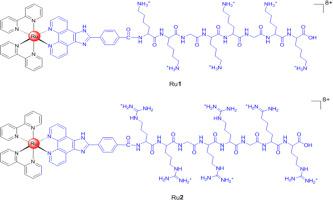Journal of Inorganic Biochemistry ( IF 3.8 ) Pub Date : 2020-07-03 , DOI: 10.1016/j.jinorgbio.2020.111171 Juan Zhu 1 , Fangfang Wang 1 , Xiaohua Liu 2 , Lifeng Tan 3

|
In this work, using [Ru(bpy)2(pip)]2+ (bpy = 2,2′-bipyridine, pip = 2-phenyl-1H-imidazo[4,5-f]-[1,10]-phenanthroline) as chromophores and neutral amino acid glycine as spacers, two novel Arg- and Lys-rich Ru(II) polypyridyl metallopeptides as an intermolecular triplex RNA stabilizers, namely [Ru(bpy)2(pic-Lys2-Gly-Lys2-Gly-Lys2)]8+ (Ru1; pic = 2-(4-carboxy-phenyl)imidazo-[4,5-f] [1,10] phenanthroline, Gly = glycine, Lys = lysine) and [Ru(bpy)2(pic-Arg2-Gly-Arg2-Gly-Arg2)]8+ (Ru2; Arg = arginine), have been synthesized and characterized. The binding properties of Ru1 and Ru2 with poly(U)·poly(A)∗poly(U) triplex have been studied by UV–Vis spectroscopy, fluorescence spectroscopy, viscosity measurements as well as circular dichroism and thermal denaturation. The obtained results suggest that attaching cationic peptides to a Ru(II) polypyridyl complex can obviously enhance the triplex stabilization. Considering the structure natures of Ru1 and Ru2, conceivably besides electrostatic interaction, the forces stabilizing the triplex should also involve hydrophobic interaction and hydrogen binding. Compared with the Lys-rich metallopeptide (Ru1), however, the third-strand stabilizating effect of the Arg-rich one (Ru2) is slightly more marked, which may be due to differences in the interactions of arginine and lysine residues with the third strand of the triplex. The results obtained here may be useful for understanding the interaction of triplex RNA poly(U)·poly(A)∗poly(U) with small molecule, particularly ruthenium(II) complexes.
中文翻译:

分子间RNA三链体的稳定由两个新颖的富含赖氨酸和Arg的Ru(II)多吡啶基金属肽。
在这项工作中,使用[Ru(bpy)2(pip)] 2+(bpy = 2,2'-联吡啶,pip = 2-苯基-1 H-咪唑[4,5- f ]-[1,10] -菲咯啉)作为生色团,中性氨基酸甘氨酸作为间隔基,两种新型的富含Arg和Lys的Ru(II)聚吡啶金属肽作为分子间三链体RNA稳定剂,即[Ru(bpy)2(pic-Lys 2 -Gly-Lys 2 -Gly-Lys 2)] 8+(Ru 1; pic = 2-(4-羧基-苯基)咪唑-[4,5- f ] [1,10]菲咯啉,Gly =甘氨酸,Lys =赖氨酸)和[Ru(bpy)2(pic-Arg 2 -Gly-Arg 2 -Gly-Arg2)] 8+(Ru 2; Arg =精氨酸),已经合成并表征。通过紫外-可见光谱,荧光光谱,粘度测量以及圆二色性和热变性研究了Ru 1和Ru 2与poly(U)·poly(A)* poly(U)三重体的结合性能。获得的结果表明,将阳离子肽连接到Ru(II)聚吡啶基复合物上可以明显增强三链体的稳定性。考虑Ru 1和Ru 2的结构性质可以想象,除了静电相互作用外,稳定三重态的力还应涉及疏水相互作用和氢键。与赖氨酸富metallopeptide(RU相比1),然而,该第三链stabilizating(RU的精氨酸-富一个的效果2)略微更加显着,这可能是由于在精氨酸和赖氨酸残基的与所述相互作用的差异三元组的第三条链。此处获得的结果可能有助于理解三链RNA poly(U)·poly(A)* poly(U)与小分子,特别是钌(II)配合物的相互作用。











































 京公网安备 11010802027423号
京公网安备 11010802027423号